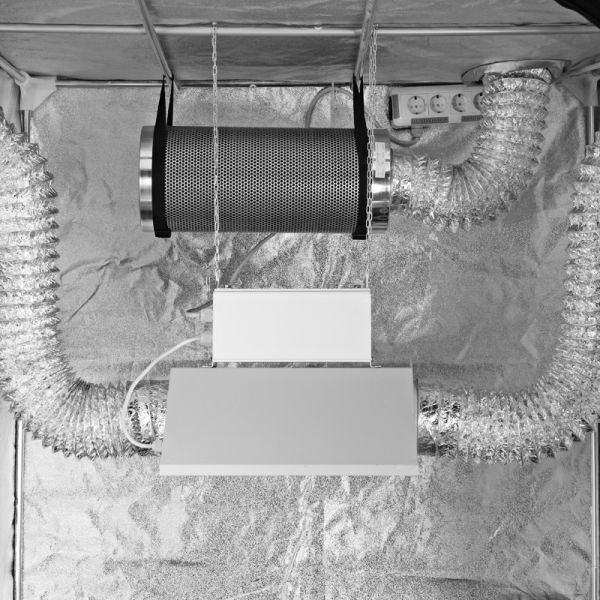A Quick Guide to Ventilation in a Grow Tent
For effective ventilation inside a grow tent, you’ll need an inline duct fan. This type of fan is considered the most efficient and common in ventilation systems, and it’s used to extract hot air from the lamp in the tent (with or without ducting). These fans are powered by a 220V electrical supply and come in various shapes (round and rectangular). You can find them at hardware stores that sell ventilation equipment or at construction markets.
The quietest fans are the Soler & Palau SILENT series (look them up online)—that’s what I use myself. These models have an airflow capacity ranging from 160 m³/h to 400 m³/h, with power consumption between 35W and 50W. The noise level of these fans is between 18dB and 33dB, respectively. To help you understand the decibel scale, here are some approximate examples:
- Noise level in a quiet room – 30 dB
- 35 dB – Comparable to a whisper from 16 feet (5 meters) away
- 45 dB – Similar to a conversation at 33 feet (10 meters) or the sound of soft music
- 50 dB – Like a quiet conversation at 10 feet (3 meters)
- Noise above 50 dB draws attention and can be distracting, similar to a loud conversation at 16 feet (5 meters)
- Pain threshold for noise – 130 dB
To create the most effective ventilation inside your tent, ensure there’s an unobstructed and shortest possible path for airflow from the floor to the ceiling, with enough volume to cool the lamp. Air should be refreshed every 3–5 minutes. To achieve this, calculate the volume of your tent (Height x Width x Depth) and compare it to the fan’s capacity.
Using Circulation Fans for Plant Canopies
You’ll also need household fans to blow air over the tops of your plants. I used to use computer fans, which are still a good budget option for growers. However, I now prefer more practical and expensive fans with clip mounts, which let you fix the fan exactly where you need it inside the grow tent. Why are these fans important?
- I use fans for air circulation almost from the very beginning, which helps make the plants stronger and more resilient by exposing them to airflow resistance.
- Circulation fans are necessary to cool the tops of the plants and prevent burns from the lamps.
- They help prevent mold. If you’ve ever dealt with mold, you know how big of a problem it can be—you could lose your entire harvest. Strong airflow over the plants is especially helpful in high-humidity conditions.
For example, a year ago I had poor air circulation in my grow space and couldn’t keep up with removing mold spots—I almost cried, losing about 20% of my harvest and having to cut everything down a bit early. This year, I took precautions and bought two household fans, made some improvements to insulation, and even though my hygrometer showed at least 70% humidity, everything went smoothly with no losses.



